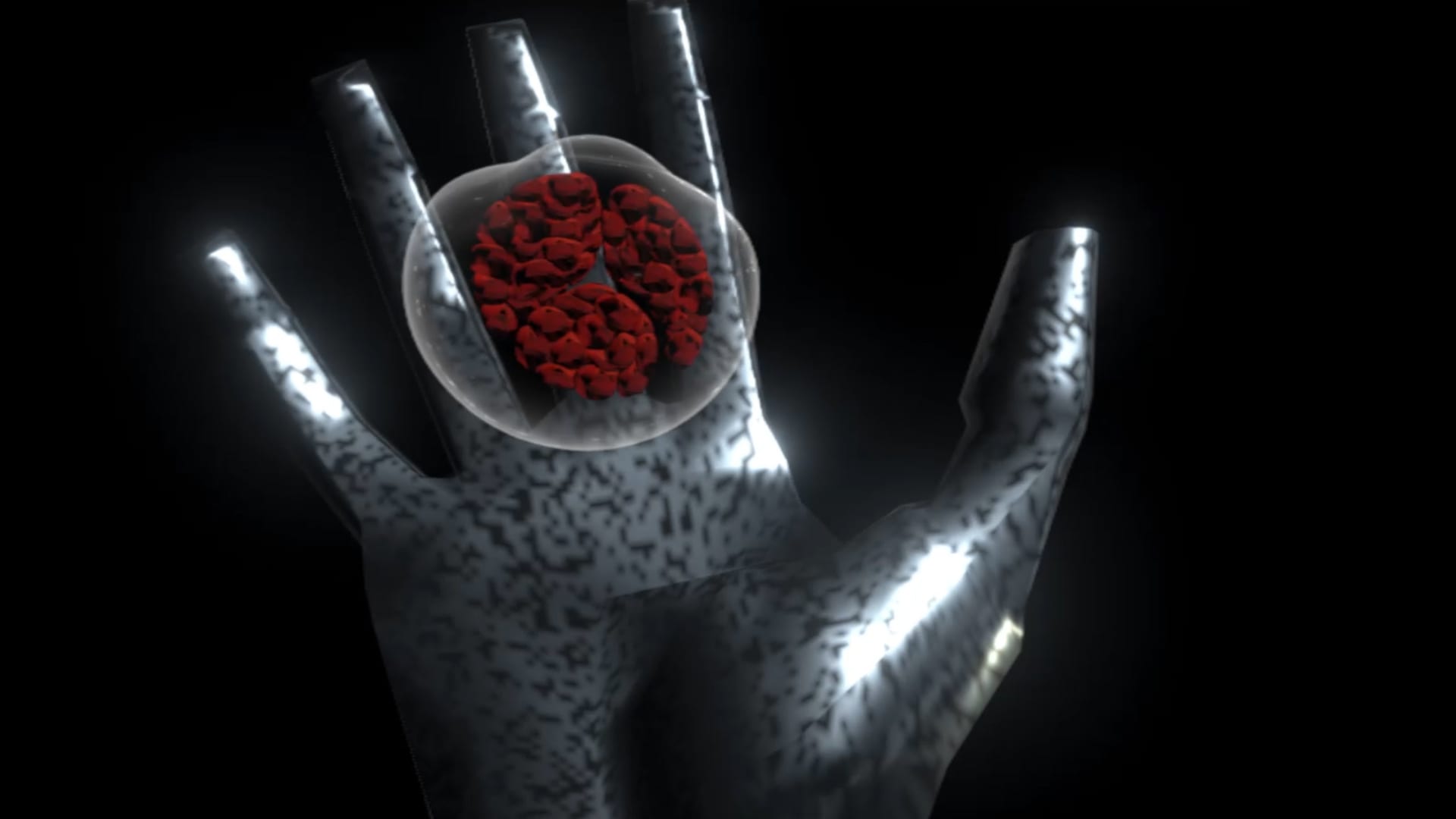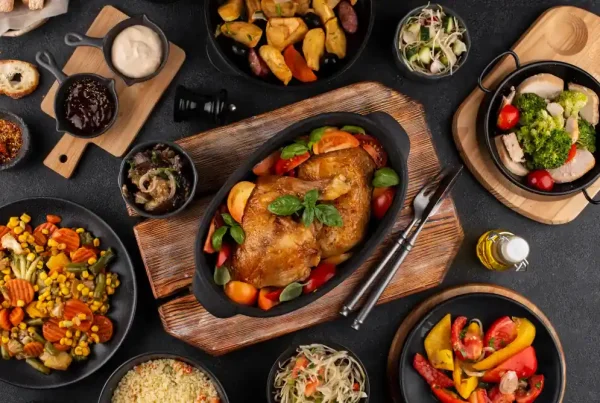- Virtual reality dining is still a pricey novelty — costing as much as $2,000 — but it does have the potential to create a new kind of food experience.
- If VR technology is adopted more broadly it could become a bigger part of creating memorable, and profitable, food experiences, as well as be a tech-based source of addressing health issues in society.
- As the coronavirus creates a global “social distancing’ phenomenon, including in developed countries with large elderly populations, and more individuals turn to food delivery, VR could ultimately help address isolation caused by pandemics.
Hannah Kulczak and her boyfriend Rigo Deleongovea, self-described millennial “foodies” from California and video game enthusiasts, went in search of an answer to this question on a recent trip to New York City. They decided to celebrate a birthday with a meal they couldn’t see in reality. The couple, along with this writer, were dining companions at a virtual reality meal experience hosted by The James Beard Foundation.
Over the course of an hour, seven small courses were served in what the organizers describe as a “virtual and augmented reality art and dining experience” — at a price of $125. After a glass of champagne and a brief lesson on how to eat from the “food vessel” — throw the food back like a shot without spilling it all over the place — the diners were seated and strapped into a Facebook Oculus headset.
Floating objects and oversized foods began to appear. There were pink pineapples and blue cherries falling from the sky, meat dancing through the air and colorful environments that seemed to light up with each dish. This was all set to music and narration which described dishes like a “mousse of roasted hopes.” Before each course a table would appear with an object representing food the diners were about to eat. For example, one dish appeared as a red sphere on a plate and this cued the narrator to say, “I think it tastes like the whistle that the wind makes through a door lock on a cold autumn afternoon.”
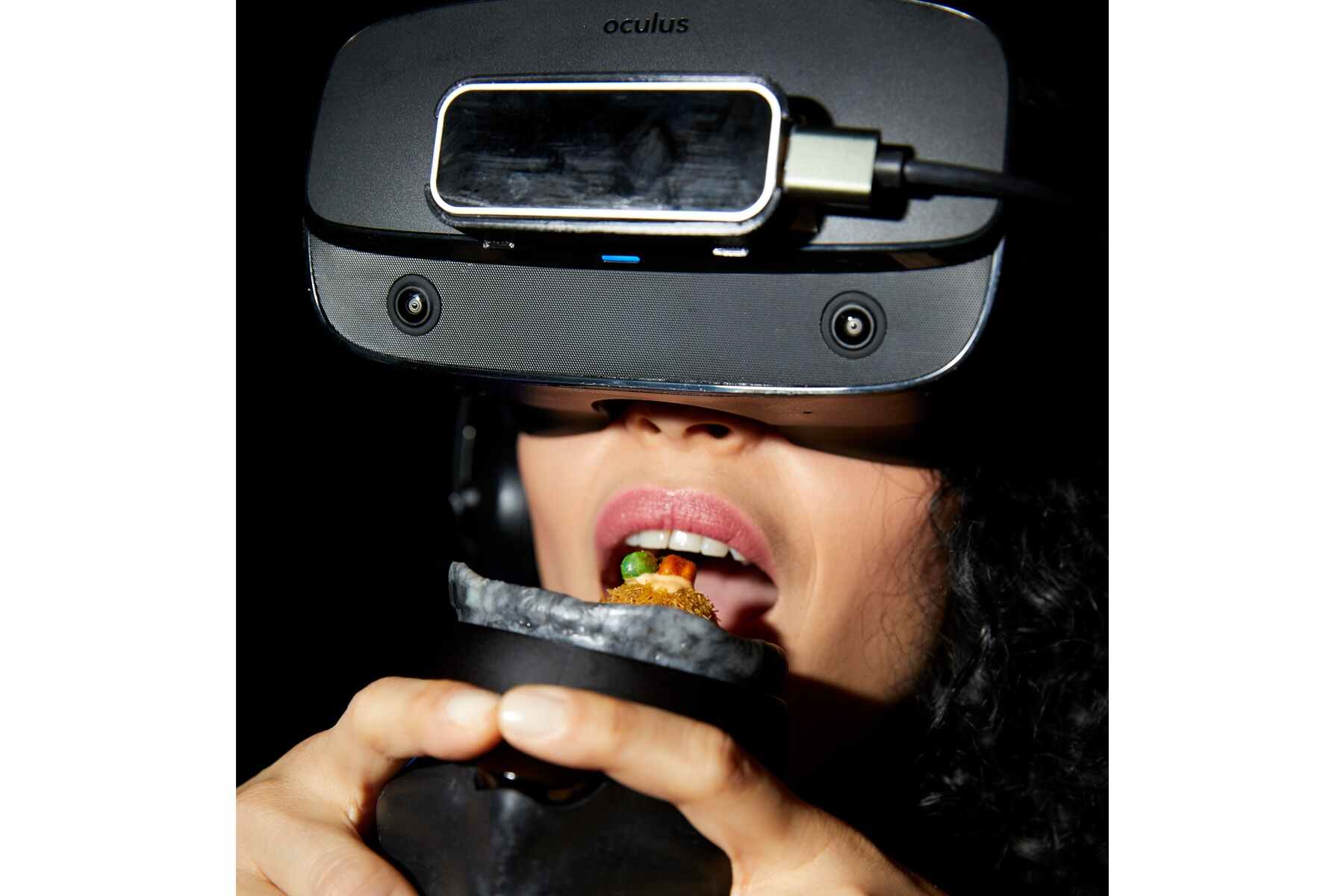
As the bites kept coming, some flavors were recognizable — a spicy bite, a fruity bite, a bite that tasted like meat — and none, thankfully, tasted like a whistle. Kulczak said she enjoyed the food and recognized a few of the items, including the first course of watermelon and mint, and another featuring toast with truffle.
The dining experience, called Aerobanquets, was a way to attract new people to the organization, said Mitchell Davis, chief strategy officer at James Beard Foundation. The foundation hosts roughly 200 dinner parties a year featuring top chefs. These dinners are held at the Manhattan townhouse in Greenwich Village that was once the home of legendary chef and cookbook author James Beard.
A $2,000 meal in VR
One of the longest-running VR dining experiences is in the luxury vacation hotspot of Ibiza, Spain. Started in 2014, Sublimotion is a 12-course haute cuisine extravaganza combining food, art, music and virtual reality technology. Created by double Michelin starred chef Paco Roncero, the gastronomic performance is brought to life by a team which includes a stage director, musical director, fashion designer, illusionist, craftsman and several Michelin starred chefs. The three-hour experience doesn’t come cheap. At a price nearly $2,000 per person, it’s one of the most expensive meals in the world.
In recent years, companies have experimented with virtual reality in a variety of applications. In 2015, UK cheese brand Boursin created a VR experience to sell soft cheese. That same year Nescafe partnered with Google to take users on a virtual trip to coffee fields in Brazil. In 2017 KFC, released a VR training video to teach employees how to fry chicken. Project Nourished, a VR food start-up, has been experimenting with technology to trick taste buds and promote sustainability. Imagine, for example, tasting a steak not made from a cow. The progress of its project remains under wraps.
Today, events like Aerobanquets, Sublimotion, and Tree by Naked, a VR dining experience in Japan, remain expensive to produce, and their prices reflect that. Over time — as the price of virtual reality comes down and its adoption widens — VR could drive customer experience in the restaurant sector as businesses look for ways to be more relevant and attractive to a younger, tech-savvy consumer.
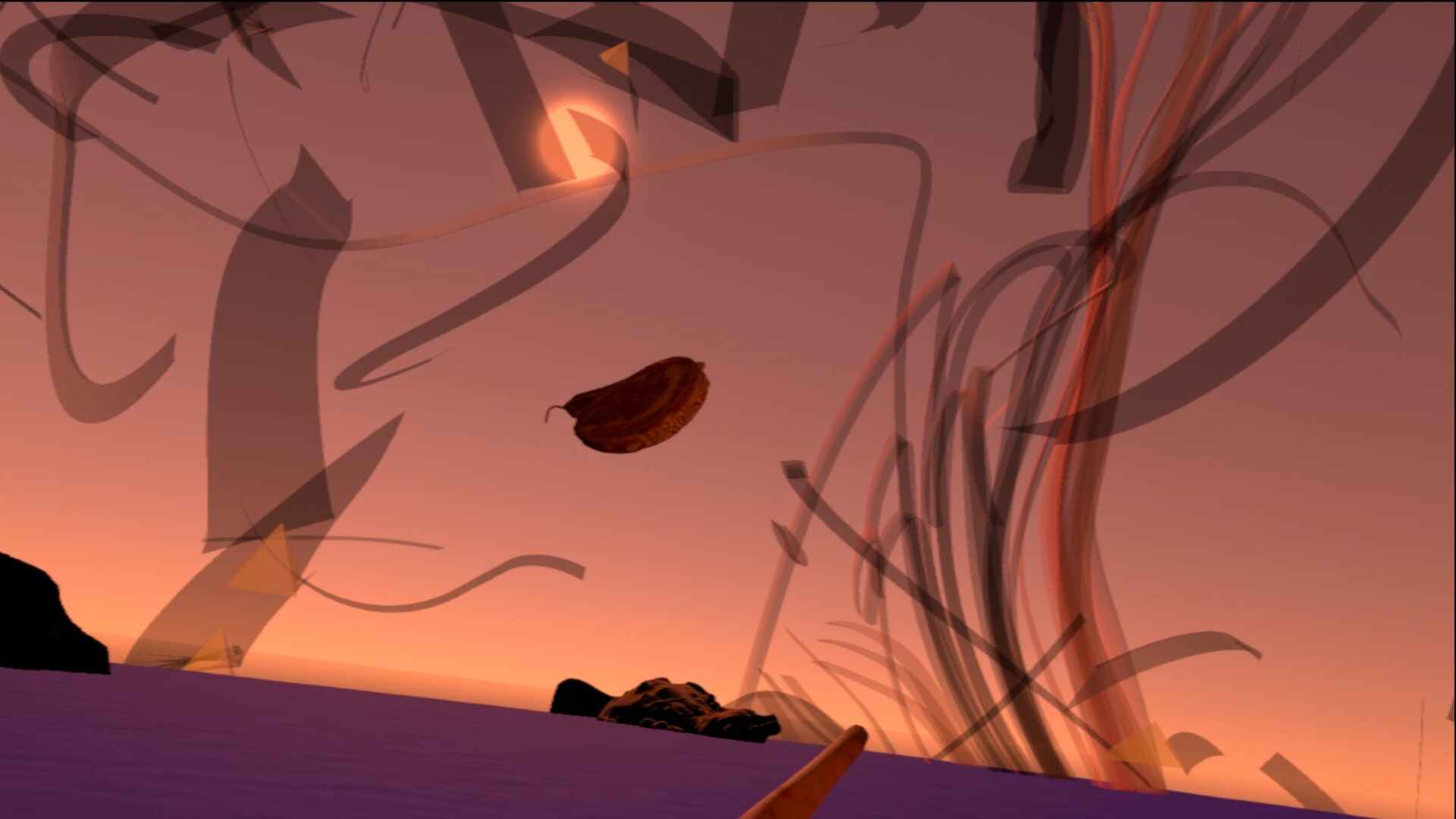
“I thought I was going to be in a real life video game and I would never be able to look at food the same way,” Kulczak said. “Aerobanquets was unlike any dining experience I have encountered. It was one of a kind, and some of the best foods and flavors I have ever had,” she said. “I would absolutely do this dining experience again.”
That’s the kind of reaction Davis was hoping for when he brought the VR experience to the James Beard Foundation. “People don’t expect this from James Beard House. But this is the type of thing we should be using the house for,” he said. “Thousands of people come here over the course of a year and as we think about the future of food we want to assert ourselves and our art as a cultural art form.”
Millennials like Kulczak represent 25% of U.S. consumer society and have an estimated $600 billion in purchasing power. They are also at the forefront of food trends: eating healthy, pushing for higher quality ingredients and advocating for sustainable sourcing from restaurants. Millennials want more than a meal when they go out to dine, they also want an experience they can talk about and share on social media. Restaurants have responded by serving up camera-ready food in a more social friendly environment — special lighting, funky wallpaper and catchy neon signs. Despite the fact that VR masks isolate each diner, virtual reality could be the ultimate step in creating a shareable dining experience for the social media era.
What science is learning about senses
Charles Spence, an experiment psychologist at the University of Oxford who focuses on the human mind and multisensory food experiences, said VR is the latest way to test how human experience can be manipulated.
His Crossmodal Research Laboratory at Oxford has been working with a large, high-end hotel group on different ways to bring technology to dining tables in their resorts. That may include projection of images, playing of sounds and the releasing of scents. The multisensory experience can turn dining into a storytelling experience, Spence said, noting there are already theaters in the U.K. where moviegoers are brought certain foods to eat throughout the film that are tailored to the screen story. The opportunity to turn a meal into an elaborate story is not something chefs alone can make successful. “Chefs aren’t trained as storytellers so this is where it plays more to the strength of a Disney,” Spence said.
Luxury entertainment brands won’t be the only ones creating exciting food and beverage experiences. Spence stated “The best ideas will come out of niche undertakings, working with a local gastropub or a branded sensory app on a mobile device,” He also believes big growth will come when brands of ice cream, tea, whiskey, coffee or beer realize they can’t compete just on taste, but also need to compete on experience.
“To make people buy more [you] ultimately need to make a better experience,” Spence said. “TV dinners of the 1950s had nothing to do with what was on TV [and] now we can offer people tools with which to augment their own experience.”
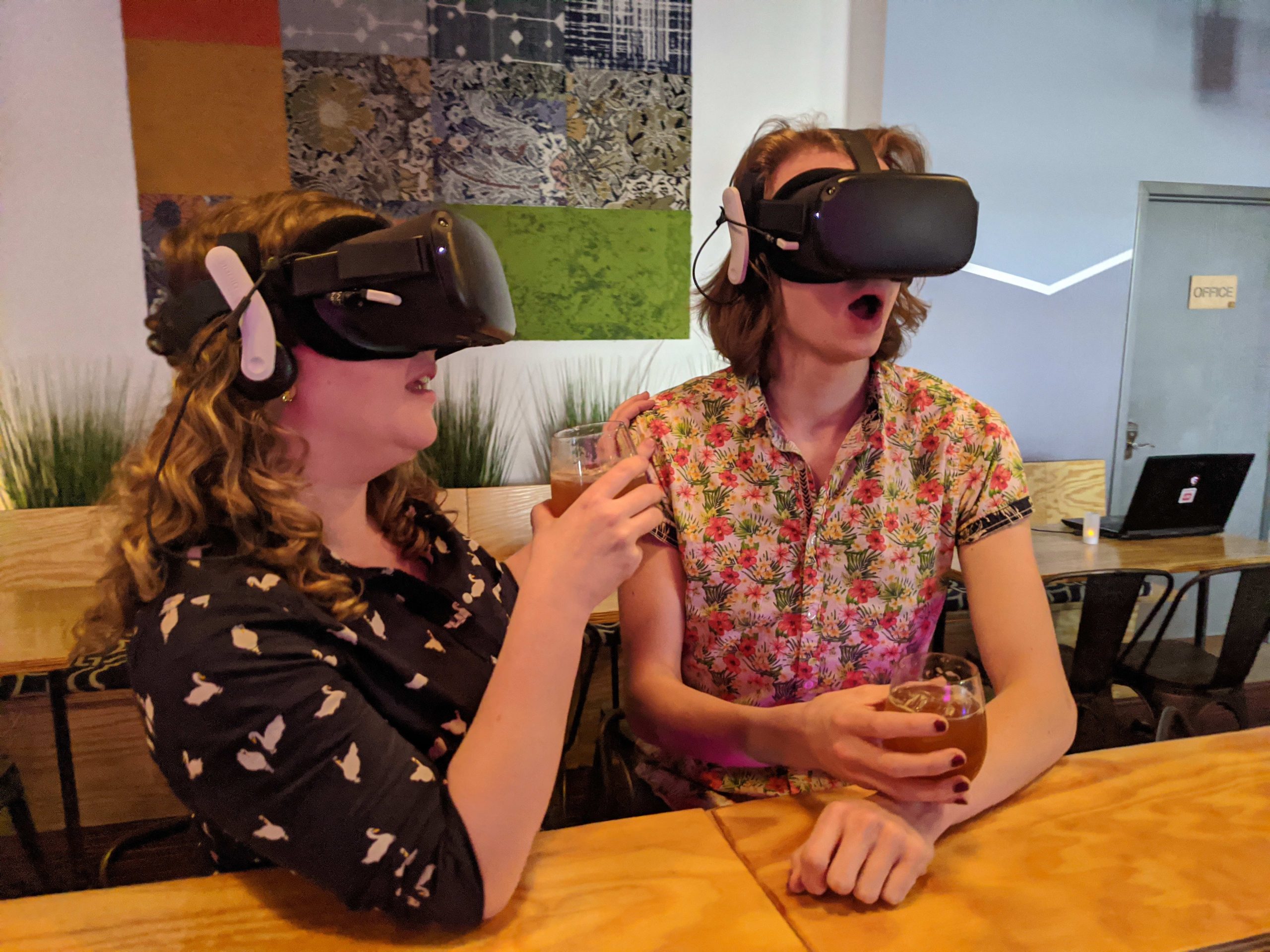
Virtual reality has the potential to bring significant entertainment value to the restaurant industry. However, Spence said this technology could also create major societal benefits in an era where more and more people are living alone. In some countries, like Sweden, as much as half of the population live alone, and eating alone has been known to have a negative impact on health and wellbeing. “That’s not really about entertaining or playfulness, but a real societal problem,” the Oxford researcher said.
This is an idea given immediate relevance in light of the coronavirus, which has caused social isolation on a scale never before seen in the U.S. and across the world. As COVID-19 creates a global “social distancing’ phenomenon, including in developed countries with large elderly populations, VR could ultimately help address daily isolation caused by pandemics and specifically with activities like dining.
But the wider use of VR technology will require it to be available at a reasonable price.
Robin Dando, an associate professor of food science at Cornell University, worked on a research experiment with low priced VR equipment that was presented to a food technologist conference last year. Dando used a $20 Samsung Gear headset and a Samsung Galaxy phone to study how visual perception can influence eating and drinking behavior. It turns out just changing the color of a beverage can alter the way a user experiences it.
“You would be surprised how much we rely on visual input when eating food,” Dando said.
Sound, too, has been found to have surprising power over eaters. This was demonstrated through experiments with people eating potato chips in soundproof environments to understand how much of the “crunchiness” was related to sound and enjoyment of experience.
“This is still a young field. It was all uncharted territory just a few years ago and people are just figuring out how to do it,” he said. Interest from corporations has been limited so far, but as the field develops interest is likely to grow. “We’ve already shown you can make something slightly more enjoyable so you have to imagine there would be some utility to that,” Dando said.
‘Messing with your head’ in a positive way
For the James Beard Foundation experience, Davis said his hopes were that a VR food experience “messes with your brain and disorients you in a way that could be positive. I want people to think of food in a different way, as serious, not frivolous, but fun,” he said.
The James Beard Foundation event was among the first VR dining experiences in the U.S., but Aerobanquets, the brainchild of Italian visual artist Mattia Casalegno, has previously toured China and South Korea. It was inspired by the 1932 Futurist Cookbook, which bans forks and knives and contains surreal dinners and colorful recipes like immortal trout, sculpted meats and zoological soup. It was further enhanced and brought to life by Casalegno’s passion for virtual reality.
“This project is all about how to introduce the language of taste into the virtual reality experience,” the artist said in an interview. “All scenes are inspired by the Futurist book. I picked scenes that were more effective in terms of emotions. So there is a scene that is cold and dark, a scene that is hot like summer, and a scene that is more like spring. By placing people in different spaces I was thinking how that will influence taste and expectations about what you would be eating.”
For the New York City debut of Aerobanquets, Casalegno collaborated with Chintan Pandya, a rising star chef of the highly acclaimed Indian restaurant Adda in NYC.
Kulczak found that VR heightened her appreciation for the food. She explained, “Eating and having the [virtual reality] glasses allowed me to focus on elements of food that are taken for granted when you see what’s in front of you.” She continued, “The flavors seemed more distinct, the textures more prominent. I feel like the visual art used warm and cool colors to portray a feeling and used objects like sunset to emotionally connect you to the dining experience.”
If a VR dinner seems to be too overwhelming, too intimidating or just too expensive, Redline VR bar and arcade in Chicago is currently offering a VR cocktail called a “Pierced Navel” which is the bar’s take on a fuzzy navel. Aaron Sawyer, the artistic director and creator of the VR drink experience, describes it as “a live guided journey through your drink.” The bar is currently offering one VR drink but the plan is to offer 4 different VR cocktails throughout the year.
Source: Here’s what a meal at a virtual reality dining experience tastes like

